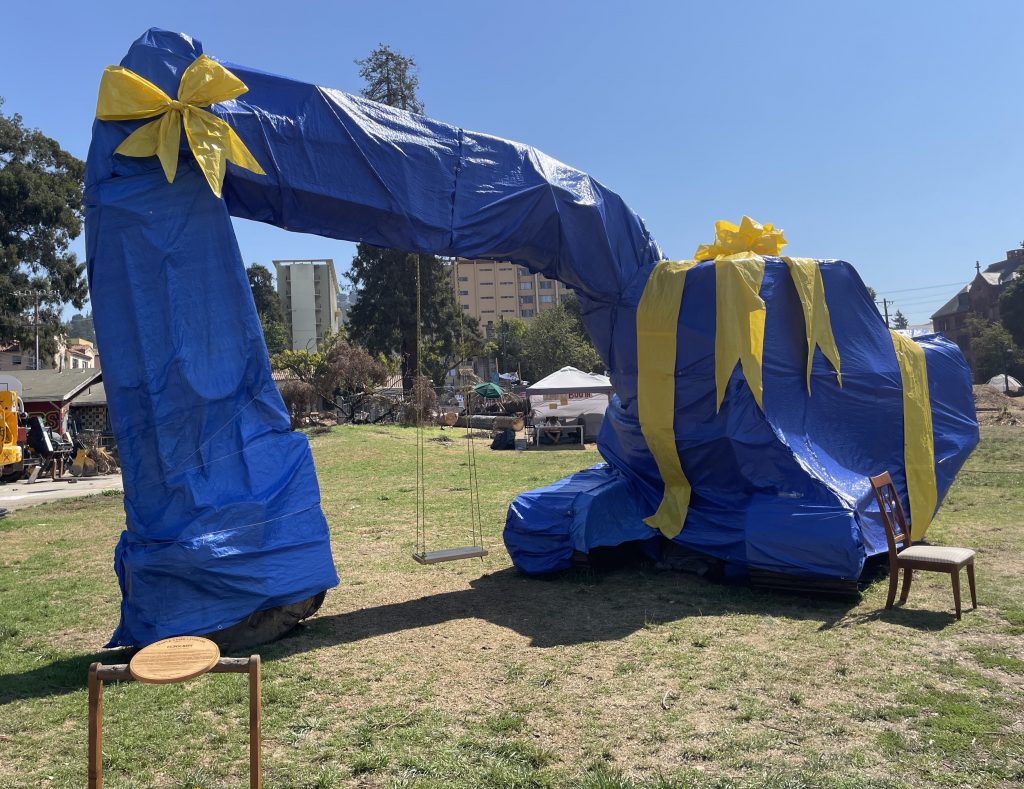Slingshot is an independent radical newspaper published in Berkeley since 1988.
Making this paper is as much about building community as the publication itself. There’s a lot of meetings where we exchange ideas — but also socialize, tell stories, hear about parties and feel seen and heard. The Long Haul community center feels alive and exciting when we make an issue. The process is very loose — there’s no official “staff” — so it is always a surprise and a treat seeing who will come in. People from a lot of different backgrounds and different ages come through our cluttered loft. So it can be a little more interesting than a punk show or a party where everyone is kinda in your scene already or a friend of a friend. Also folks come in who’ve been reading the paper for years but we’ve never met before — so it confirms that someone actually reads this thing.
It is humbling making a paper and casting it out into the world like a message in a bottle. We have no idea who might end up reading it but it seems like at least some copies filter out to new readers who’ve never been in touch with our scene before. Which is of course the point — to get outside the internet echo-chamber algorithms that increasing separate people into homogenous marketing lists. We’re hoping that our volunteer distributors can put some of the papers into places no would would expect to see an underground rag from Berkeley — truck stops, dentist offices, rodeos, weddings, military bases. If you’ve never seen the paper before — howdy, happy to meet you. Stay in touch.
The Long Haul where we have our office sorely needs to start doing more events, so if you’re in the East Bay, please schedule something — DIY workshops, sing-alongs, sign making, seed swaps, poetry readings — be creative.
A new project at the Long Haul is a risograph print room. It’s still very new and the structure and purpose behind it are a bit vague. We look forward to the new zines and paper revolutionaries coming up from it. reprographixed.com.
But jeez note to self: we really need to spend some time between issues cleaning the office and doing other background stuff like fixing the broken website. Even more crucial is spending some time decentralizing and spreading out the work load so making a paper doesn’t vacuum up so many weeks.
We know a lot of subjects are missing from this paper like the Parker School struggle, the recent homeless camp clearances on Wood Street, refugee abuse, drones being sold to Turkey for genocide, gentrification, the rise of far right-wing governments in Europe … the list feels endless. Next issue send us articles about any of the topics you see missing.
The free, word-of-mouth, 24-hour hot tub behind an unmarked gate on Essex Street in Berkeley is no more after its operator died. The tub brought relief and wonder to Slingshot staffers over the last 35+ years – what a gift to give to strangers – what a magical experience to dip into scalding hot water and then wander in an altered state of consciousness in silence through redwoods, even though you’re right in the middle of the city. Feeling tiny explosions on your naked skin and realizing with a chuckle— this is what rain feels like. It’s frustrating and sad that the operator never moved past his trans-exclusionary attitude, yet the space itself was a unique fixture of the Berkeley roller coaster.
Slingshot is always looking for new writers, artists, editors, photographers and distributors. Even if you feel you are not an essayist, illustrator, whistleblower you may know someone who is. If you send an article, please be open to editing. We’re a collective, but not all the articles reflect the opinions of all collective members. We welcome debate and constructive criticism.
Thanks to the people who made this: Andy, Dor, eggplant, Elke, Finn, Hannah, Jennifer, Jesse, Josette, Josh, Lydia, Lola, Marley, Mello, Mimi, Patrick, Rachelle, Riley, Robin, Ryan, Sean, Sebastian, Silver, Stuart, Sylvia, Thelonius, Tess & all the authors and artists!
Slingshot New Volunteer Meeting
Volunteers interested in getting involved with Slingshot can come to the new volunteer meeting on January 8 at 7 pm at the Long Haul in Berkeley (see below.)
Article Deadline & Next Issue Date
Submit your articles for issue 137 by January 28, 2023.
Volume 1, Number 136, Circulation 22,000
Printed October 28, 2022
Slingshot Newspaper
A publication of Long Haul
Office: 3124 Shattuck Avenue Berkeley CA 94705
Mailing: PO Box 3051, Berkeley, CA 94703
510-540-0751 slingshotcollective@protonmail.com
slingshotcollective.org • twitter @slingshotnews
instagram/ facebook @slingshotcollective
About the Cover artist:
Salvatore Giommarresi is a comics author, illustrator, He’s a former member and editor of many editorials projects (magazine about illustration and comic).
His work draws inspiration from a variety of different sources and especially from what he experiences first-hand during his travels around the world. He likes experimenting new ways to apply traditional techniques such as origami to his art.
He is particularly interested in exploring the potential of comics in education. Currently, he organizes workshops and cooperates with schools, institutions, and NGOs at international level.
His pieces have been exhibited in Italy, Spain, Mozambique, France, Vietnam, U.S.A., and Albania.
Circulation information
Subscriptions to Slingshot are free to prisoners, low income, or anyone in the USA with a Slingshot Organizer, or $1 per issue donation. International $3 per issue. Outside the Bay Area we’ll mail you a free stack of copies if you give them out for free. Say how many copies and how long you’ll be at your address. In the Bay Area pick up copies at Long Haul and Bound Together books, SF.
Slingshot free stuff
We’ll send you a random assortment of back issues for the cost of postage. Send $4 for 2 lbs. Free if you’re an infoshop or library. slingshotcollective.org

